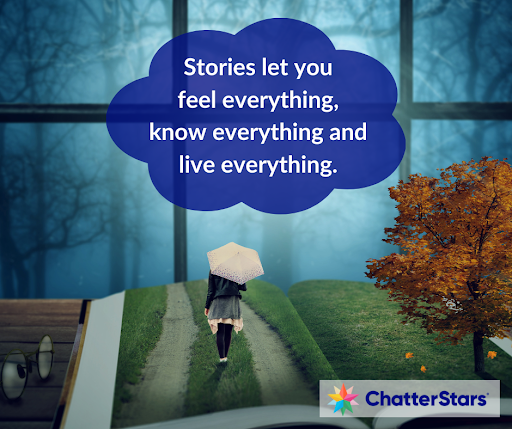Chatterstars Reading Fluency
What is Reading Fluency? + Top Tips to Develop Reading Fluency
By Anna Hart
23/03/2024
Learning about reading fluency
Learning about reading fluency, its importance and the link between vocabulary and reading fluency will help you to support your children in developing their word recognition and reading skills. In this blog post, we’ll explore everything you need to know about reading fluency, including our top tips to help children develop their reading fluency over time.
What is Reading Fluency?
First of all, let’s clarify what exactly reading fluency is. Reading fluency is the ability to read fluently, i.e. accurately, smoothly, at an appropriate speed and with expression. Fluent readers sound natural and effortless when reading because their word recognition becomes ‘automatic’.
The three key elements of reading fluency are as follows:
- Prosody – Reading aloud with the proper intonation, expression and pauses, including reading punctuation accurately and using expression to sound like natural speech.
- Accuracy – Reading a text correctly without making many errors.
- Reading speed – Reading at an appropriate rate without going too slowly or too quickly.
Why is Reading Fluency Important?
Reading fluency is an essential skill for children to learn, so they can understand texts and be able to navigate the world around them. We all need to read during our daily lives. As children go through school, reading on their own becomes more and more important. Reading skills can be thought of like a master key that helps them learn, think better and understand others, setting them up for a lifelong adventure of learning and exploring the world.
Being able to read fluently means learners can focus on the meaning of a text and understanding what they’re reading, rather than how to pronounce each individual word. The more a child reads, the more they’ll learn about all sorts of different topics, which will help to broaden their knowledge.
Word recognition, comprehension and vocabulary development will all improve when reading fluency improves, so it’s a win-win all round!
How Are Reading Fluency and Vocabulary Connected?
Having a developed vocabulary is a key indicator of future academic success and is intricately linked to reading fluency. This is because the wider a learner’s vocabulary is, the more easily they will recognise words in a text and, thus, the more fluent their reading will become.
Supporting a learner to develop their vocabulary is a key way to encourage them to read more because reading becomes more fun when we understand more words – the easier reading is, the more we’ll want to do it!
Completing vocabulary activities in the classroom or doing some fun vocabulary practice at home is a really important (and fun!) way to help children develop their reading fluency.
The Development of Reading Fluency
When first learning to read, a learner’s fluency is usually low, meaning their reading can sound ‘choppy’. This is because their attention is focused on decoding and figuring out each word one by one.
As learners develop their language comprehension and speaking skills throughout Reception and Key Stage 1, their word recognition and vocabulary will naturally expand. By practising their reading skills throughout Key Stage 2 and 3, alongside continuing to develop their vocabulary, learners will become more and more fluent when reading aloud.
How to Support Children to Develop Their Reading Fluency
There are some important things that we can do as educators, parents and carers to support children with developing their reading fluency. Here are our top tips and ideas to help you get started:
- Choose engaging texts – It’s vital to select exciting books that will encourage children to explore further, including allowing children to choose their own next read. Fluency develops progressively as pupils encounter and re-read books with new vocabulary and language structures, so it’s especially helpful for pupils to re-read books they liked, as familiarity with a text supports the development of reading fluency.
- Read aloud regularly – As the latest findings from the Department of Education’s 2023 Reading Framework indicate, regularly reading aloud to children is a very important factor in helping them develop their reading fluency: ‘The more frequently teachers read aloud across the curriculum, the more pupils experience the impact of fluent reading – what it sounds like and how it makes them feel.’
- Practise expression – Encourage children to practise natural pace, intonation and expression by both reading aloud to them and encouraging them to read aloud, too. Then, ‘over time, they begin to understand how a reader might share meaning through choosing which words to emphasise, and how pace, intonation and volume can be controlled’ (DfE Reading Framework).
- Provide time to read – Prioritising reading time during class and at home will ensure children have ample time to practise their reading skills and naturally develop fluency over time. Even taking 15 minutes at the end of the day to read aloud to your children can make a big difference.
- Create sociable reading environments – Reading together and sharing books, talking about their favourite books and giving or receiving recommendations (from peers and adults) can all help children get excited about reading. Social reading environments are a great motivator for children to pursue reading and, therefore, develop reading fluency.
- Encourage library use – Both local public libraries and school libraries are wonderful places for children to explore books they’re interested in and discover new titles to continue their reading adventure. Perhaps you can set aside a day a week to take a trip to the library and do some reading together – perfect for quality time and boosting reading fluency at the same time!
- Support vocabulary development – Developing their vocabulary is a really important way for children to improve their reading fluency. Thankfully, we’ve made vocabulary development fun with our award-winning ChatterStars app. Children can earn stars by playing games and completing activities designed to boost their vocabulary, making learning fun, easy and accessible.
- Keep a word book – Children can keep a log of all the words they learn in their very own word book, which is a book with a section for each letter from A to Z where children can write down all the new words they come across while reading. This will help children remember new words and steadily build their vocabulary and, thus, their reading fluency over time.
So, now we’ve shared all our top tips to help children develop their reading fluency, we’d like to leave you with a parting thought about the value of reading and stories:
Happy reading, from all of us here at ChatterStars!

